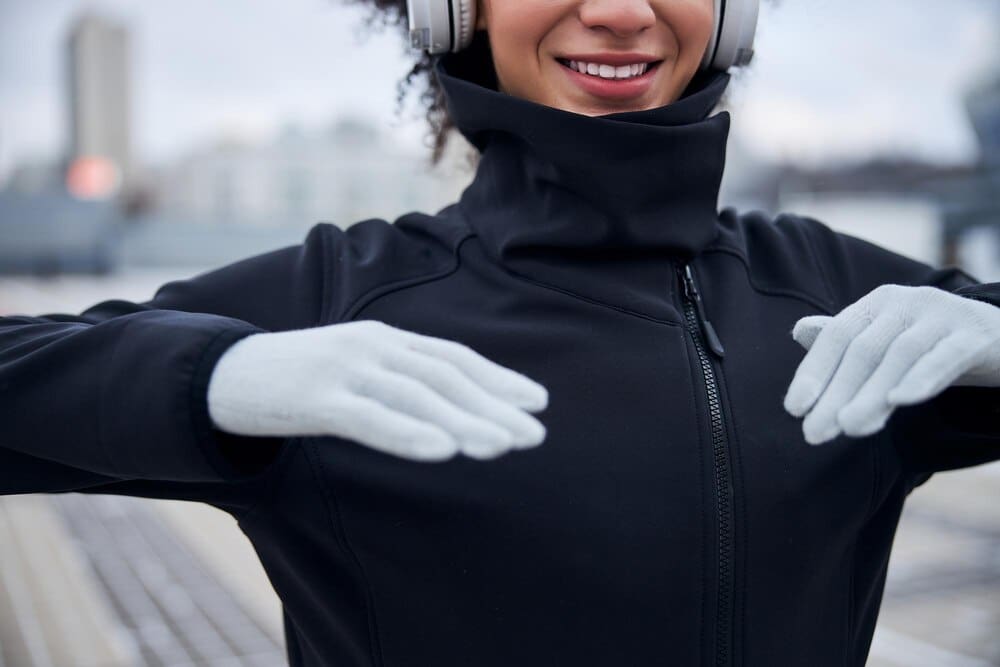The key to comfortable and safe winter running is not a single, perfect jacket but a strategic, adaptable system of clothing known as layering. For any runner heading out in cold, windy, or wet weather, this three-part system—consisting of a moisture-wicking base layer, an insulating mid-layer, and a protective outer layer—is the most effective way to manage body temperature and stay dry. The fundamental principle is to trap warm air close to the body for insulation while simultaneously allowing sweat vapor to escape, preventing the dangerous chill that occurs when moisture cools on the skin. Mastering this technique empowers runners to easily adjust to changing conditions and personal exertion levels, transforming winter from a season of hibernation into a prime opportunity for training.
Why Layering is a Non-Negotiable Skill
Running generates a significant amount of heat, even on the coldest days. The primary challenge isn’t just staying warm, but managing the sweat produced in the process. When you wear one single, heavy layer, that sweat becomes trapped against your skin. While you might feel warm initially, the moisture will eventually cool, robbing your body of precious heat and dramatically increasing the risk of hypothermia.
A proper layering system addresses this by creating a microclimate around your body. Each thin layer traps air, and this trapped air is what provides the bulk of your insulation. Because the layers are distinct, moisture can move from the layer closest to your skin outward, eventually escaping or evaporating. This wicking process is the most critical function of a good layering strategy.
This is why seasoned winter runners live by the mantra: “Be bold, start cold.” You should feel slightly chilly for the first five to ten minutes of your run. This initial discomfort is a sign that you’ve dressed correctly. Your body will quickly generate enough heat to warm the air trapped between your layers, bringing you to a comfortable temperature without causing you to overheat and sweat excessively early in your workout.
The Anatomy of a Perfect Layering System
Understanding the specific role of each layer is essential for building an effective system. Think of it as a team where each player has a distinct and vital job: wicking, insulating, and protecting.
The Base Layer: Your Second Skin
The base layer sits directly against your skin and has one paramount job: to pull sweat away from your body. This process, known as wicking, is the foundation of staying warm and dry. If this layer fails, the entire system fails.
For materials, choose synthetics like polyester or polypropylene, or a natural performance fiber like Merino wool. These fabrics do not absorb moisture; instead, they pull it from your skin and push it to the outer surface of the fabric where it can evaporate. Merino wool is a particularly popular choice as it wicks effectively, provides excellent insulation even when damp, and is naturally odor-resistant.
The one material you must absolutely avoid for a base layer is cotton. Cotton is hydrophilic, meaning it loves water. It will absorb your sweat like a sponge, lose all of its insulating properties, and cling to your skin, making you cold, clammy, and miserable. The fit of your base layer should be snug and next-to-skin to perform its wicking function efficiently, but it should not be so tight that it restricts your movement.
The Mid-Layer: The Engine of Insulation
The mid-layer is your primary insulating piece. Its job is to trap the body heat that you generate, keeping the air warmed by your body close to you. The thickness and material of your mid-layer will vary the most depending on the temperature.
Excellent mid-layer materials include fleece, which is lightweight, breathable, and insulates well even when damp. Heavier-weight Merino wool sweaters or zip-ups are also fantastic options. For very cold and dry conditions, a lightweight down or synthetic-fill vest or jacket can serve as a powerful mid-layer, offering incredible warmth for its weight.
Look for mid-layers with features that add versatility, such as a half-zip or full-zip design. This allows you to easily vent excess heat as you warm up during your run without having to remove the entire layer. The fit should be slightly looser than the base layer to create that crucial pocket of trapped air, but not so baggy that it becomes cumbersome.
The Outer Layer: Your Shield Against the Elements
The outer layer, or shell, is your defense against wind and precipitation. It protects the warm air you’ve trapped in your other layers from being stripped away by the elements. The type of shell you need depends entirely on the day’s weather conditions.
For cold, dry, and windy days, a simple wind-resistant jacket is often sufficient. These are typically lightweight, highly breathable, and designed to block the chilling effect of the wind.
If there is light snow or mist, a water-resistant shell is a better choice. These jackets are treated with a Durable Water Repellent (DWR) finish that causes moisture to bead up and roll off. They offer a good balance of protection and breathability.
For runs in heavy rain or wet snow, you will need a fully waterproof and breathable shell. Look for jackets made with membranes like Gore-Tex or similar proprietary technologies. These materials have microscopic pores that are large enough to let sweat vapor out but too small to let water droplets in. Be aware that even the most advanced waterproof jackets have a trade-off; they are inherently less breathable than a simple wind shell.
Don’t Forget Your Extremities
A perfectly layered torso won’t do you much good if your hands, feet, and head are frozen. These areas are often the first to feel the cold and require their own layering strategies.
Legs and Lower Body
For most cool runs, a single pair of standard running tights or pants is enough. As the temperature drops, switch to fleece-lined or thermal tights that incorporate a brushed interior for added insulation. In very cold or windy conditions, you can layer a pair of wind-resistant pants over your tights to provide an extra layer of protection, mimicking the system on your upper body.
Head and Neck
You can lose a significant amount of body heat through your head. A simple beanie made from a technical fabric or Merino wool is essential. For very cold days, a balaclava provides full-face protection. A neck gaiter or buff is an incredibly versatile tool that can be worn as a neck warmer, pulled up over your face and nose, or used as a headband.
Hands and Feet
Your fingers and toes are highly susceptible to frostbite. For your hands, mittens are generally warmer than gloves because they keep your fingers together, sharing warmth. A great system for extreme cold is to wear a thin pair of liner gloves inside a heavier, wind-proof mitten. This gives you the option to remove the mitten for tasks requiring dexterity without fully exposing your skin.
For your feet, the rule about avoiding cotton is paramount. Choose moisture-wicking socks made from Merino wool or synthetics. You can opt for a slightly thicker sock for more warmth, but ensure your shoes are not too tight, as this can cut off circulation and make your feet colder. In slushy or wet conditions, trail running shoes with waterproof uppers can be a lifesaver.
Putting It All Together: A Temperature Guide
While personal preference and exertion level play a huge role, here is a general framework for how to apply these layers based on the “feels like” temperature, which accounts for wind chill.
- 40°F to 50°F (4°C to 10°C): A long-sleeve base layer and shorts or light tights. You may not need a mid-layer.
- 30°F to 40°F (-1°C to 4°C): A long-sleeve base layer, a light mid-layer vest or quarter-zip, and running tights.
- 20°F to 30°F (-7°C to -1°C): A moisture-wicking base layer, a fleece mid-layer, and an outer shell if it’s windy. Thermal tights, a hat, and gloves are a must.
- 10°F to 20°F (-12°C to -7°C): A thermal base layer, an insulating mid-layer, and a protective outer shell. Add thermal tights, a warm hat or balaclava, and mittens.
- Below 10°F (-12°C): All of the above, potentially adding a second mid-layer or wind-proof pants over your tights. Prioritize protecting all exposed skin with a balaclava or neck gaiter.
Remember to adjust based on your workout. For a high-intensity interval session, you generate more heat, so you can dress as if it’s 10 to 20 degrees warmer than the actual temperature. For a slow, long recovery run, you may need an extra layer.
Ultimately, layering is a personal science that you perfect through experience. By understanding the principles of wicking, insulating, and protecting, you can experiment with your gear to find the combination that works best for you. The right clothing system doesn’t just make winter running possible; it makes it a genuinely rewarding and enjoyable experience, opening up a whole new season for your training.







